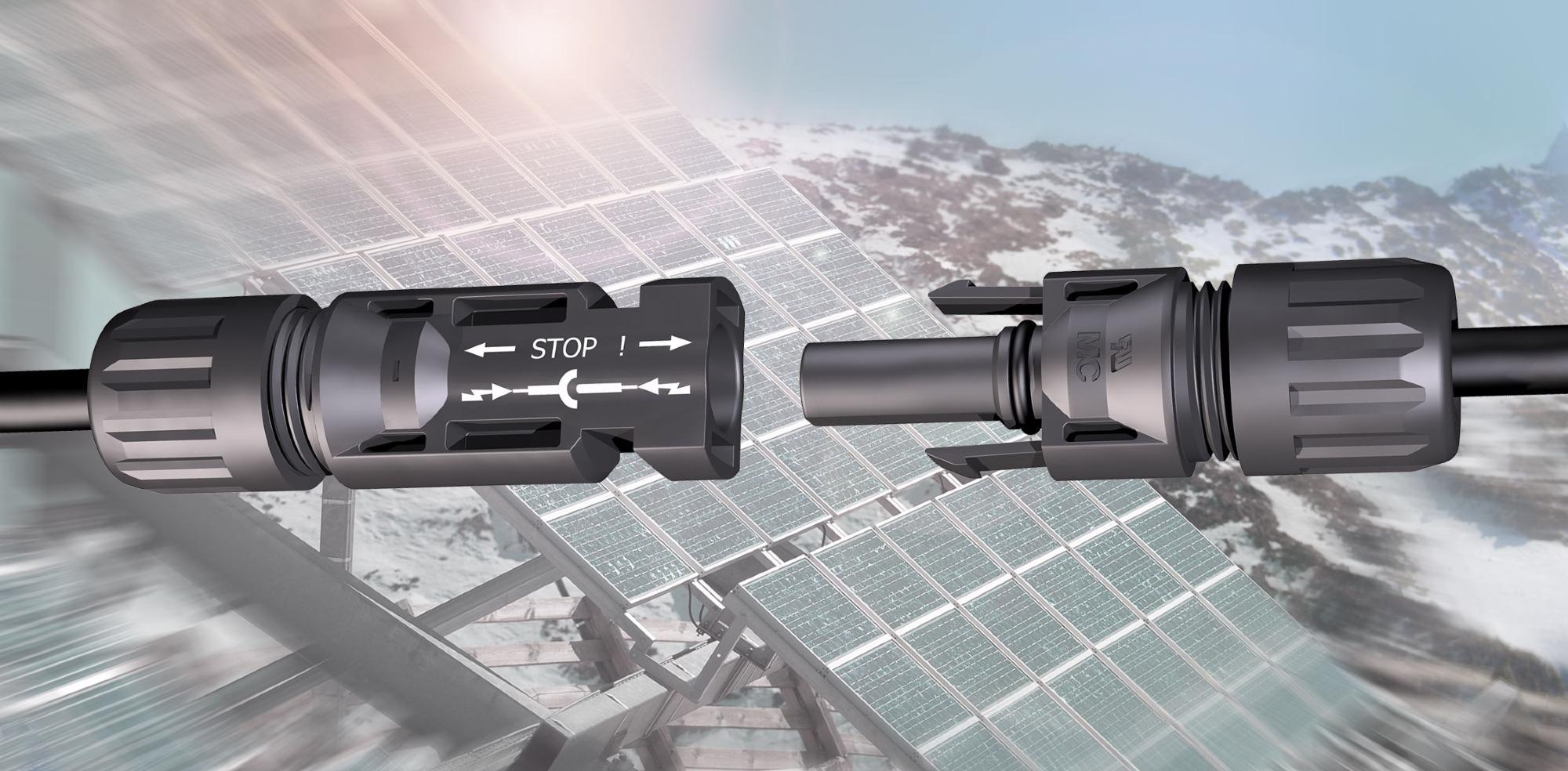 Interview conducted by Olivia FrostJan 21 2021
Interview conducted by Olivia FrostJan 21 2021Brian Mills, product manager of photovoltaics at Stäubli and Kayla Tescallo, Marketing Coordinator from Stäubli talk to AZoM and answers questions about their original MC4 electrical connectors, the most widely used PV cable coupler in the world.
Could you start by giving our readers a brief overview of Stäubli Electrical Connectors?
Headquartered in Pfäffikon, Switzerland, Stäubli was originally founded in 1892 and currently has over 5,500 employees in offices across 29 different countries. We have four main business divisions in our company: robotics, textiles, fluid connectors and electrical connectors. Stäubli acquired Multi Contact (a privately owned company founded in 1963) to form its electrical connector division. The Multi Contact name was retired in 2017 and it is now known as Stäubli Electrical Connectors.
Staubli has a very diverse, wide-reaching product offering of electrical connectors, spanning from large switchgear connectors to miniature PCB connections. One of our most well-known product groups is our photovoltaic portfolio. Staubli was a pioneer of the PV cable coupler industry in the early 1990s, completely changing how PV modules would be interconnected, with developments still in use to this day.
The MC3, as it was known, became the most widely used and recognized connector in the world. The MC3 connector was the first connector to truly prove itself as a product built to last more than 20 years in service without issue. In the early 2000s, to address the new requirements of the rapidly changing PV industry, the MC4 connector was developed. To this day, the MC4 connector is the most widely used PV cable coupler in the world.
Finally, in the mid-2010s, Stäubli introduced the newest member of the PV connector portfolio: the Evo2 connector. The Evo2 was designed and developed to meet the latest demands of the global PV industry and to achieve the highest possible rating levels. To date, over 314 GW of PV generation has relied on Stäubli PV connectors - far more than any of our competitors. All major players in the PV module, MLPE and eBOS product markets rely on Stäubli connector products for safety, reliability and performance.

Photovoltaic panels. Image Credit: Shutterstock.com/foxbat
What components would an average PV system need to operate efficiently?
PV couplers like the MC4 may be the most well-known products, but PV systems require a complete portfolio of connector products, which often include panel mount connectors, branch connectors, cables, inline fuses and test plugs. Stäubli’s PV cable coupler products are all tested and certified to the highest international standards and requirements. This includes up to 1500 V Safety Class II and up to 70 A-rated. We have IP65 and IP68 ratings on the enclosures themselves for ingress protection and above and beyond the requirements, we also test our products for protection against ammonia exposure and salt spray mist.
One of the most important aspects of all connectors is the contact range between plug and socket. This is where Stäubli really shines and thanks to our proprietary MULTILAM technology we are able to maintain a low contact resistance of 0.25 micro Ohms. It is also important to realize that cable couplers by themselves are just parts in a bag. It is the system of connectors, designated cable/sizes, appropriate tooling and proper assembly steps that dictate the actual performance and safety of the product.
Cable couplers are comprised of a metal contact (plug/socket) and an insulator that protects them. They are generally designed to work with specific types of cable, cable conductor cross-sections (AWG or mm²) and cable outer diameters (OD).
What sort of environments and conditions would PV couplers be expected to operate under?
PV cables must operate in some of the most challenging environments imaginable, from the hottest day of the year through to the harshest winter and through perpetual UV exposure, humidity and under rapidly varying temperatures.
It is also important to think about the sort of power levels that PV connectors must be able to accommodate. A typical 1500 V utility-scale system with connectors operating at up to 50 A would have to accommodate 75 kW of DC energy passing through the connector. A typical US home has 220 V / 200 A service, meaning that connectors must accommodate 44 kW of AC energy. These connectors are responsible for protecting a significant amount of energy and that is over a 20-30 year service life.
Designing products to safely meet such demanding requirements takes years of experience, dedication to quality and rigorous validation standards. The smallest product issue or deficiency, or mistakes made during assembly or deployment, can have very dire consequences, including arcing issues and, in some cases, fires.
One of the biggest issues we see today stems from cross-mating – the practice of plugging two different connector products from different suppliers together. There are lots of products available that may seem compatible, but there is no such thing as an MC4 compatible connector and no certifications cover installations where cross-mating practices are used. It also voids product warranties and, perhaps most importantly, it is a violation of the national electrical code.
What is ‘bankability’ in the context of PV systems?
PV systems are sold as a promise of future energy generation and revenue. Improperly designed systems made with low-quality or unproven components can jeopardize the system’s energy generation potential and create profit losses through excessive maintenance costs.
Bankability is the concept that a company has a proven track record of reliability, experience and dependability. Despite being small components, PV connectors can cause major issues if they are not properly installed and maintained. Choosing cheaper, less proven connector products upfront may save money initially, but this can lead to extensive long-term costs in terms of maintenance and downtime. When designing a system, users should always use quality components from the start.

An MC4 connector.
When I look at your catalog, I see that there are two different size MC4 connectors listed that will work with my cable: how do I know which one to choose?
When you have a choice between two different connector products because your cable lies within the range of both, it is best to choose the connector on the top end of the sealing range. The cable will work fine with both, but it is better to be at the top end of the sealing range because as you tighten the seal, it shrinks down to the cable’s size. The less you must do this before it reaches the cable, the better.
I have my own crimp tool that I paid a lot of money for and have used for years: why do I need your specific crimp tool?
I understand that buying different expensive crimp tools is not appealing, but as we mentioned earlier, the actual PV system, the tooling and the assembly instructions are all part of a validated system that is referred to by our certifications. The specific tools that we supply and the specific crimp-dye configuration has been tested by both Stäubli and the certification agency and have been validated.
It is likely that we have no idea what will happen if you use your own crimp tool with our product and with the cables we have specified, so we cannot vouch for or warrant that tool. Our certification does not cover this scenario and that has a lot of downstream ramifications because electrical codes require you to have a product that is certified for its intended use.
My crew left some of your connectors unplugged during our installation and they were lying in the dirt for a few days. What can I use to clean them out with?
There is no validated or acceptable method for cleaning out the connectors if they are dirty. The connectors use a very delicate contact element called the MULTILAM. It is very precisely designed, very small and intricate and once soil or dirt enters these areas, it is impossible to be sure that it has all been removed. This may also contaminate sealing surfaces and the O ring itself and using a cleaning product could affect the electrical connection as it coats the contacts with residue.
The best approach is to be preventative and stop the connectors from getting dirty in the first instance. We do offer cable coupler seals that are very robust and that are reusable if they are well cared for. We have a lot of customers or installers that have a box of female and male protective caps. These are used on the connectors out in the field and only removed right before the connectors are plugged together.
We have some of your red assembly wrenches that we use to tighten the gland nuts on your connectors with and we have always just turned them until they clicked a couple of times to know they are tightened correctly.
I don't know specifically where that rumor began, but it is certainly not what the assembly instructions say. The assembly wrench is simply a useful way to pre-tighten cable gland nuts. There would be no way to design a plastic tool that would be suitable for ongoing use in the range of conditions our PV connectors are used within.
Realistically, applications need a specified torque for the cable gland because of the amount of compression on the seal. As with the crimp tool, it is best to follow the assembly instructions and use the tools already validated and certified for use as part of the PV system.
Concerning cross-mating, I understand that it is not recommended. Is there any circumstance that it would be ok to use two different brands mated together with the same amperage?
No, the only time this would be acceptable is if two companies were working together and their products were specifically designed to be cross-compatible and they had gone through all the testing and certification requirements, gaining what is known as a co-certification for compatibility. This is not currently possible, however, because there have been so many field issues with this practice.
Disclaimer: The views expressed here are those of the interviewee and do not necessarily represent the views of AZoM.com Limited (T/A) AZoNetwork, the owner and operator of this website. This disclaimer forms part of the Terms and Conditions of use of this website.